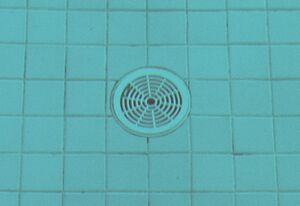Pool Drain Risk

Pool drain risk (abbreviated to PDR) refers to the possibility of safety incidents linked to drainage systems in swimming pools. The correlation between pool drains and hazard to human life has been observed by many different accounts since throughout human history.[1] It is widely believed that a lesser number of pool drains directly translates to an increased risk of Delta P incident, which, while generally true, recent studies have proposed that more variables are at play when determining such an outcome.
Research on pool drain risk is limited, even in modern times. There is currently one nonexperimental study on the matter reviewed by multiple authors as of August 2023.
Details
The most prevalent risk posed by drains in pools is injury or death by pressure entrapment, in which a swimmer is sucked onto the drainage intake of the pool. The force of high-pressure water rushing into a lower-pressure intake causes the victim to be trapped and unable to free themselves. As a result, drowning or severe internal injuries can occur.
Between 2004-2015, 150 incidents of pressure entrapment in swimming pools were reported on internationally. Additionally, 56 cases of related but distinct types of entrapment occurred across the same timeframe. Nearly all entrapment incidents result in injury, with ultimately fatal result being not uncommon.[2]
Theory
The basis for theoretical assessment is to objectively quantify the level of risk present in a PDR-susceptible scenario. The Garf Model measures PDR in the unit ChloeOne (plural: ChloeOnes, symbol: CO), and defines the base formula for PDR as:
where is the number of drainage intakes inside a pool.[3] This shows that risk varies inversely with the number of pool drains.
The full formula takes into account the base PDR value, pool swimmer density, overall drain coverage, and density of the pool's liquid medium.[4]
where , is the number of swimmers inside the pool area, is the area of the pool, is the average area of all drainage intakes,[5] and is liquid density.[6] The divisor is derived from the special pool property.[7]
Of note is that . Thus, it can be said that pools with one drain are of infinite pool drain risk.[8] For any pool of , .
An interactive model of this is available here.
Criticism
Opponents of the Garf Model generally describe its research methodology as a "circlejerk". One account commented that "It means literally nothing .. It does not affect anything .. These statistics mean nothing at all".[9] Another statement, directed at the authors, reads: "You are all on fucking crack".[10]
History
Public attention to pool drain risk was first brought to Garfcord on the 17th of July, 2023 in #fun-facts.[11] Widespread panic promptly erupted among the userbase.
On the same day, a case study was conducted in #genderal regarding the role of pool drains in Delta P incidents. The study sought to synthesize a viable means of evaluating pool drain risk. Individuals involved in the effort include 1, Chloe Desirée, god (not the Abrahamic one), bomblitz06, Arazorias, et al. The discussion proceeded for several hours, transforming #genderal into #pool-draineral during this time.[12] They concluded that single-drain pools are of infinite risk, eventually catalyzing the absolute annihilation of reality, of which there will be no escape.
The topic gradually garnered controversy; different users countered the discussion in #pool-draineral as it interrupted usual conversation. Eventually, the moderation team intervened after numerous /srs complaints. Mention of pool drains in #genderal was banned, finishing the server's short-lived pool drain arc.[13]
References
- ↑ https://phys.org/news/2015-11-toilets-sewers-ancient-roman-sanitation.html
- ↑ Avezaat, J., & Göb, A. (2015). Entrapment Accidents Caused by Drainage Systems in Swimming Pools: A Statistical Study of Accident Victims and Unsafe Environments Found in Field Research. https://www.thebluecap.com/site/documents/210/full-paper-069-a.-gob-germany.pdf
- ↑ https://discord.com/channels/959267794409652274/1059217965360357406/1130456306466168915
- ↑ https://discord.com/channels/959267794409652274/1011124836132728873/1142537139037405295
- ↑ Presumably in square meters; original documentation leaves this ambiguous
- ↑ Presumably in kg/m3
- ↑ Any perceived connection in naming is a mere coincidence
- ↑ https://discord.com/channels/959267794409652274/1059217965360357406/1130456965303247008
- ↑ File:Criticism1.webp
- ↑ File:Criticism2.webp
- ↑ https://discord.com/channels/959267794409652274/1000246953155760168/1130255737512284160
- ↑ File:pool-draineral.webp
- ↑ File:pooldrains1984.webp











